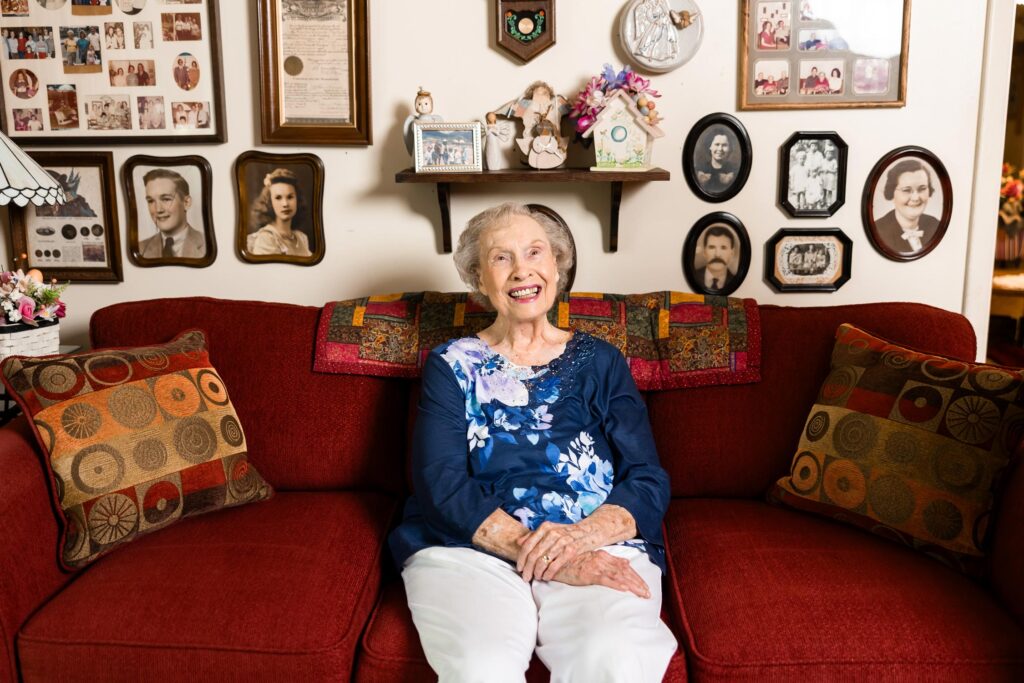Is your parent more comfortable at home than anywhere else? You're not imagining it. Many older adults in central Arkansas prefer to stay in their homes as they age—and with good reason. Aging in place can give your loved one more control, more peace, and a better life. But is it the right choice for your family? Let’s look at the real benefits of aging in place and what’s needed to make it work.
Key Takeaways:
- 90% of seniors prefer to age at home due to comfort, autonomy, and emotional ties.
- Familiar environments reduce stress, anxiety, and the risk of memory loss.
- Daily routines and personal space improve self-worth and emotional health.
- Staying home costs less than assisted living—seniors save by avoiding rent or loans.
- Home updates may include grab bars, slip-proof mats, and better lighting.
- Smart devices like fall detectors and stove timers help prevent accidents.
- Programs like Medicaid waivers and VA funds pay for house changes.
- In-home care plans can match changing needs over time.
- Being at home supports connection through family, neighbors, and local groups.
- Walkable, accessible towns with nearby services help maintain safety and ease.
- Planning early for home safety and money matters leads to better results.

The Life-Changing Benefits of Aging in Place
As people grow older, many are choosing to remain in the place they know best: their own home. In fact, the benefits of aging in place go far beyond comfort—they touch every part of a senior’s emotional, physical, and financial well-being. According to AARP, nearly 90% of adults over 65 want to stay in their homes as they age. This powerful preference continues to shape how we think about senior care, community planning, and personal independence.
Familiar Homes Offer Emotional Security and Lifelong Comfort
One of the most important benefits of aging in place is emotional peace. Home is more than a building—it’s where memories live. The sound of the hallway floor, the smell of your favorite chair, the light that floods your kitchen in the morning—all these small details offer comfort every day.
Moreover, familiar surroundings help reduce stress and anxiety. Transitioning to a new environment can be disorienting and emotionally draining. At home, seniors enjoy control, routine, and security, which together create a strong foundation for mental wellness.
Strong Community Ties Strengthen Social and Emotional Health
Neighborhoods where seniors have spent years—or even decades—often hold deep personal meaning. That’s why the benefits of aging in place include community connection. Whether it’s a wave from a neighbor, a trip to a familiar grocery store, or a visit from a longtime friend, these small interactions build a sense of belonging.
Studies, including those from AARP, show that older adults value proximity to trusted people even more than proximity to healthcare. Being close to friends and family often leads to better mood, greater mobility, and longer life.
Autonomy and Routine Are Vital for Personal Dignity
Control over daily life is essential. Making decisions like what to eat, when to go to sleep, or how to spend the day can deeply impact a senior’s self-esteem. The benefits of aging in place include the ability to maintain this autonomy.
Living at home also supports long-standing routines. Whether it’s watering plants, reading the paper in a favorite chair, or attending a weekly church service, these habits provide structure and joy. Personalized routines help seniors feel more in control, which in turn supports better emotional and physical health.
Staying Home Supports Mental and Cognitive Health
In many cases, remaining in a known environment can slow cognitive decline. It is one of the primary benefits of aging in place. Familiar surroundings act as memory cues, helping seniors living with conditions like dementia navigate daily tasks more easily. Known spaces also reduce confusion, frustration, and fear.
Additionally, sleep quality often improves at home. A quieter, more comfortable environment supports rest and recovery, which are crucial for cognitive clarity.
Personalized Spaces Offer Emotional Stability
Home is where personal history lives. From the family photos on the walls to the favorite mug in the cabinet, every detail helps seniors stay connected to their identities. This connection can be especially comforting during times of grief or loss.
Creating a space that reflects personal preferences also enhances emotional stability. Whether it’s a quiet reading nook or a lively kitchen filled with memories, home becomes a healing environment.
For more resources on creating supportive home spaces, visit CareLink’s contact page.
Financial Benefits Make Aging in Place a Smart Choice
In addition to emotional and mental advantages, the benefits of aging in place include significant financial savings. Assisted living facilities often cost tens of thousands of dollars per year. In contrast, staying at home—especially in a paid-off home—can reduce monthly expenses dramatically.
While some home maintenance is necessary, it's generally far less expensive than paying for full-time care in a facility. Seniors can also control costs by choosing only the services they need, such as housekeeping, transportation, or meal delivery.
Government Programs Help Fund Home-Based Living
Various programs support seniors who wish to remain at home. Medicaid waivers, tax incentives, and grants can help cover home modifications like ramps or improved lighting. Medicare may also provide coverage for in-home medical care, such as physical therapy or nursing.
Local agencies and nonprofits often offer free home safety assessments and minor repairs. Seniors can also explore options like reverse mortgages for additional funds, though it’s important to consult a trusted financial advisor first.
CareLink and similar organizations can help seniors and families navigate these options and create a plan that works.
Independence and Pride Grow Stronger at Home
Autonomy is more than convenience—it’s a core part of our identity. Seniors who make their own decisions tend to feel more confident, more capable, and more respected. The benefits of aging in place include keeping that independence intact.
Whether it’s choosing meals, hobbies, or daily schedules, these small decisions add up to a meaningful life. Familiar routines, from gardening to morning walks, support both physical health and emotional resilience.
Home Modifications Make Aging in Place Safer
Falls are among the most common risks for older adults. Fortunately, simple home updates can make a big difference. Installing grab bars near toilets and showers, adding nightlights, removing tripping hazards, and improving stair safety are all effective ways to reduce risk.
Smart home technology, such as stove shut-off timers, motion sensors, and video doorbells, can also enhance safety. Voice assistants can remind seniors to take medications or alert caregivers in emergencies.
Resources like the AARP HomeFit Guide provide detailed suggestions for home upgrades.
Social Connection Flourishes in Familiar Settings
Another one of the powerful benefits of aging in place is the ability to stay socially connected. Whether it's chatting with a neighbor, attending a local event, or hosting family dinners, these interactions combat loneliness and build resilience.
Family members often find it easier to visit seniors who live nearby. These visits offer emotional support and practical help, strengthening family bonds and improving quality of life.
Community models like "Village" networks also support aging in place. These local groups offer rides, tech help, and social events—all designed to keep older adults engaged and supported.
Staying Home Can Improve Physical Health
Moving to a facility often involves a loss of control and familiarity, which can increase stress and weaken the immune system. At home, seniors can move more freely, rest more comfortably, and maintain better hygiene—all of which contribute to better physical health.
In-home care services allow for personalized care plans that adapt to changing needs. For chronic conditions like diabetes or heart disease, home-based monitoring and flexible routines simplify management and improve outcomes, and are among the many health benefits of aging in place.
Early Preparation Makes Aging in Place More Secure
Planning ahead is essential. Safety upgrades, financial assessments, and family conversations should begin early—ideally while seniors are still active and mobile.
A good checklist includes:
- Installing grab bars and non-slip flooring
- Improving lighting, especially on stairs
- Rearranging furniture for easier navigation
- Placing commonly used items within easy reach
- Creating a single-level living space if possible
Financial planning should include budgeting for home maintenance, in-home care, and future medical needs. Organizing documents and designating a financial helper can also prevent confusion later on.
In-Home Services Support Daily Independence
Today’s in-home services are more flexible than ever. Seniors can choose exactly how much support they need—whether it’s a weekly housekeeper, a daily caregiver, or occasional physical therapy.
Laddered care services adapt over time. Support might begin with light chores and later include mobility assistance or medical care. This approach allows seniors to stay in their homes longer, safely, and affordably.
When signs like missed medications or frequent falls appear, it’s time to consider professional help. The right support team can extend independence while ensuring health and safety.
Communities That Support Aging in Place Make a Big Impact
Walkable neighborhoods, accessible parks, and reliable transportation all support aging in place. Cities that invest in age-friendly infrastructure help seniors remain active, connected, and safe.
Local governments also play a role by offering grants, safety inspections, and senior centers. Programs like AARP Livable Communities highlight how cities can become more supportive for aging residents.
When communities prioritize accessibility, everyone benefits—not just seniors.
Ready to Plan for Aging in Place?
Let CareLink Help You Take the First Step
Aging in place can be safe, affordable, and deeply rewarding—but only with the right plan. CareLink connects older adults and families with services, support, and guidance tailored to individual needs. Whether you're just starting to explore your options or ready to take action, we’re here to help.
Contact CareLink today to learn how you can begin building your plan for aging in place.
Choosing to remain at home is about more than comfort—it’s about preserving identity, fostering independence, and embracing life with confidence. With early preparation, strong support, and a welcoming community, the benefits of aging in place can be fully realized, bringing peace and purpose to the years ahead.





